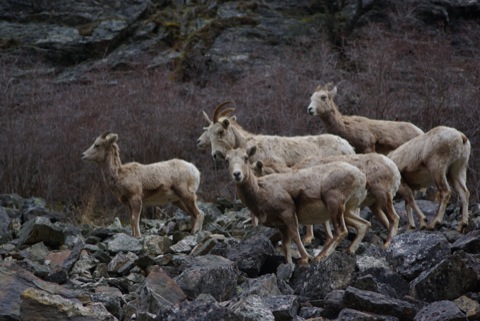This was the title of an October 15 article I wrote for the Farm & Ranch supplement of the Idaho Falls Post Register, in rebuttal to an October 1 article by Heather Smith Thomas. Heather writes a weekly column in the F&R, usually about livestock management, but she ran several consecutive columns about hard times on the range for ranchers due to wolves. A lot of her verbiage consisted of interviews with ranchers, and however much we may disagree with the sentiments, still, that’s what they said. However, when she began issuing flat, unattributed statements that there were no wolves in central Idaho before white settlement (they followed the cows and sheep in, don’t you know), I couldn’t let it pass, and e-mailed the editor, Bill Bradshaw. “Six hundred words by Tuesday,” he said, and this was the result:
Heather Smith Thomas’ article “Wolf Losses Go Beyond Actual Kills,” (Intermountain Farm and Ranch, October 1) is wrong in its assertions that wolves did not live in central Idaho before white settlement, and that “the wolves came later, following sheep and cattle herds brought into this valley.”
She cites no sources for this claim, except to mention that during Lewis and Clark’s stay in Lemhi County in 1805, they observed little game and no wolves. Apparently, if the Corps of Discovery didn’t see it, it must not have existed.
Yet, a little research would have turned up first-hand accounts of both abundant big game — and wolves — in central Idaho long before white settlement.
In 1831, for instance, the American Fur Company trapper Warren Ferris saw the Big Lost River valley “covered with Buffalo, many of which we killed.” His party also killed 100 buffalo, and two grizzly bears, on the Pahsimeroi River.
The following summer on Birch Creek, “our slumbers were disturbed by the bellowing of a herd of bulls, near us; and by the howling of a multitude of wolves, prowling about the buffalo. We were approached by a formidable grizzly bear, who slowly walked off, however, after we had made some bustle about our beds.”
On August 24, “we followed the trail to the forks of Salmon River, passing several other [deserted] encampments, which were now occupied by bears, wolves, ravens and magpies, which were preying upon the yet undevoured particles of dried meat, and fragments of skins scattered around them….in the night we were serenaded by the growling of bears and wolves, quarrelling for the half-picked bones about them.”
A few days later, “eight miles into the mountains that separate the valley of Salmon River from the Big Hole….we killed a grey wolf which was fat, and made us a tolerable supper; we likewise wounded a grizzly bear…”
They ate another wolf in the Big Hole, then wounded a buffalo. When they found the carcass the next day, it was surrounded by “thirty or forty wolves.” They drove the wolves off and scavenged the remains, while the wolves waited “politely” for them to finish. Continuing on to the Beaverhead, they bagged elk, deer, and antelope.
Between 1827 and 1832, Hudson’s Bay Company factors Peter Skene Ogden and John Work led several trapping expeditions into central Idaho, where scores of hunters and their families found abundant bighorn sheep just outside the city limits of Salmon. They killed buffalo in the Lemhi Valley foothills, saw “incredible” herds of antelope near Copper Basin, and yet more buffalo in the Pahsimeroi Valley. They trapped thousands of beaver. On what is now the INEL, buffalo were so plentiful that one of Work’s expeditions left most of the meat “for the wolves and starving Snakes [Shoshone Indians].”
In the winter of 1831-32, Captain Bonneville’s American trapping expedition moved their camp from near Carmen to the North Fork, where they found “numerous gangs of elk” and large flocks of bighorn sheep, which were easy to hunt and delicious.
In 1834, ornithologist John Kirk Townsend accompanied an expedition to the Columbia River which passed through the Salmon River country. He described an abundance of almost tame “blacktailed deer” in the Salmon River mountains. And somewhere between Big Lost River and Camas Prairie, he noticed “a deserted Indian camp” and “several white wolves lurking around in the hope of finding remnants of meat.”
Wolves are native to central Idaho. There’s no need to invent a past that never was, in an attempt to justify a point of view.
Heather has another article up this morning in the Farm & Ranch (“Wolves Go Where the Food Roams“), in which she admits that yes, there were a few wolves, but they were smaller, different wolves. Then she starts making stuff up again: “There were no elk in central Idaho in recent history.” Stay tuned as Round 2 begins!














